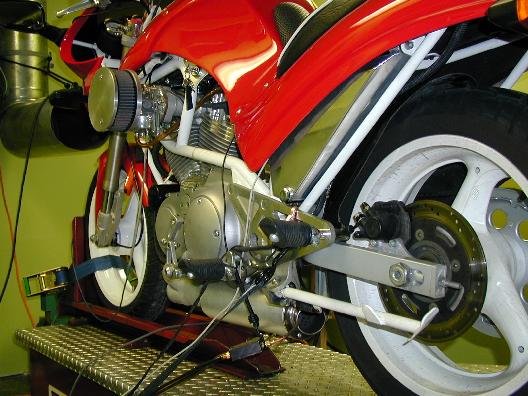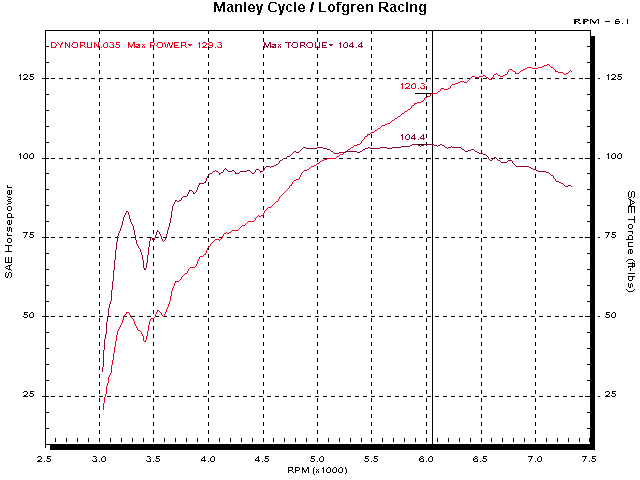
Further Adventures In Buell Abuse
A Short History
After we finished the tuning that got 122HP from his stock displacement, dual inlet Buell engine, Mike put together another engine using the heads from his S2 with the help of S&S (cases, cylinders/pistons, very-light crank, rods, and carbs), Andrews (close ratio transmission, and cams), Doc's Harley-Davidson (lots of miscellaneous engine parts, primary, transmission parts, covers, etc.) Victory 1(new titanium intake valves), and Axtell (pistons, rings, wrist pins)
Mike received the S&S parts on Tuesday and the engine came together in a chassis for race-day at BIR (Sunday.) I had divorced myself from this self-abusive process after one late-nighter, because I felt that we needed some time to tune it. Silly me! The fact that it was a complete running bike by Sunday was amazing.
It blew a head gasket on the first lap.
It's my opinion that we could have done that on the dyno! Piece-of-cake!!
The chassis had to go back to Hoban Brothers and Mike put his (re-worked) stock heads and S&S 'G' and 'Y' manifold on his engine for Sturgis.
While touring around the Black Hills, a cam bushing came loose and pushed into the crankshaft and it came rattling to a halt.
Riding season over, I'm closing my business and moving in with Manley cycle, everything gets parked!
Tom Manley decided to get a booth at the Cycle World show in Minneapolis, January 27-29. We were thinking about what bikes we'd like to have in the booth and decided that the Tularis, Reed's Monster, and Mike's S2 would be an excellent combination.
We had to get Mike's bike together. Tom and I went over to Mike's swapped Mike's partially disassembled stock engine with the S&S cased engine. Mike did most of the rest with a few evenings of help from me.
Below is the bike on the dyno

You can see the gray cord going under the side panel to the ignition module, and the Dynojet oxygen sensor going into the muffler.
The dimensions
The engine has a stock 3 13/16" stroke with 3 5/8" bore. That makes it 1289.58 ccs or 78.69 CI.
Since we had been winging the thing past 7000 RPM all of the time and it has 0.650" inlet lift, lightening the valve train seemed like a good idea. Mike re-assembled the heads with re-worked chambers (for the 1/8" larger bore) and titanium inlet valves. The compression ratio is now a little over 13:1 so we know we'll need higher than 92 octane gas.
The carbs
We're still using the S&S Super 'E's which were bored out a little. They are a simple instrument which work very well on 'Y' manifold engines, but they also respond well to changes. They are also on the short list of carbs which are large enough to do the job.
During our last round of [dual inlet] testing we knew that the top of the power curve was going lean. Not enough to loose much, if any, HP but a concern, since we wanted to see all of the potential of this combination. Plus, the bottom end of the WOT was too rich. We had worked with air-bleeds, main jets, and emulsion tubes until it ceased to get any better.
We decided to add some power jets to enhance the top end of the fuel curve. This would allow us to go smaller on the main jets to lean out the lower portion of the WOT fuel curve.
Testing
Since the compression ratio is a little high we used a 50/50 mix of Amoco Ultimate and VP C12. Previous iterations were run at 12:1 CR with Amoco Ultimate, but we felt that we were lucky to get by with that. Well, not merely lucky, since we had the fuel/air ratio correct and the ignition timing correct. I haven't found the need to use stronger ignitions where others claim they are necessary, or had detonation problems, I think, because of the practice of getting the F/A and timing correct.
We started with 50 main jets and just larger than stock main air-bleeds. In the power jets ('Whoop' jets, because Roland has used this scheme for years, and his nickname is 'Whoop') we used 1.5mm air-bleeds and 1.16mm fuel jets.
The first run was 110HP and rich, bottom to top.
The process of separating the influence of the different circuits and leaning the whole power curve, is getting easier the more we do it. One good thing about the 'Whoop' jets is, you can just un-plug the external line and take it out for a run to observe it's influence.
We ended up with 2.2mm 'Whoop' jet air-bleeds and .98mm fuel jets, and #40 S&S main-jets (0.040") and .8mm main air-bleeds (0.032".)
When we got a reasonable calibration we turned to the ignition mapping. We've been using a programmable ignition module so we can change the curve at any point we want.
From the first very rich run the engine seemed very smooth and revved, not just fast (as you'd expect with a light crank), but easily. It's hard to describe, but it's just 'sweet'. The light flywheel and close ratio transmission make shifting more like other sport-bikes.
All of the 4th gear runs were making over 125HP so we tried a 5th gear run. Bingo!!

The torque is above 100 lb-ft for 2900 RPM.
You may also notice a little stumble at 3400 RPM. The carbs don't have any accelerator pumps (taking the pumps off, drastically reduces the throttle pull) and they would just mess with the jetting and soot the plugs. Considering that I was going WOT (that's 2 S&S 'E' carbs) from 3000 RPM the little stumble is nothing.
As you can see by the number on the run, we got down to it pretty quickly this time.
All through this project, we have been refuting the 'lore' that is so prevalent among the Harley crowd;
Big carbs loose torque
Big flywheels make big torque
High horsepower engines sacrifice torque
We have tuned a bike with 2 big carbs, light flywheels and high horsepower, and is still makes big torque!
Finally, this isn't any more efficient than the previous iteration, just a little bigger and smoother. I wouldn't say that it can't get any better, but improvements will be smaller and more expensive.
And, finally, finally, we went back the next day and attempted to finish the part throttle testing. This will require some extensive modification! Stay tuned.